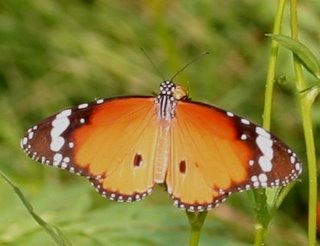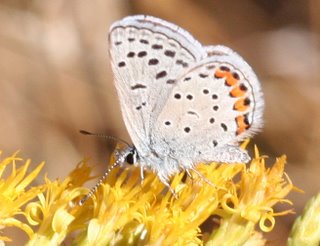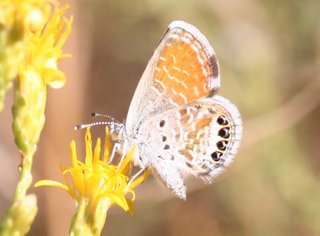I really didn’t have high expectations about this past weekend on an LA Audubon trip, as the Munroe’s (author of the Anza-Borrego book) were sending me e-mails telling me how bad it was. However this weekend was certainly was a lot better than last year when we saw only one Sara Orangetip It was actually better than I thought it would especially because we had no access to Plum Canyon this weekend, do to road repairs.
We started as usual at Yaqui Well and had lots of Becker’s White (more than I’ve seen here in several years) in and around the bladderpod. Funereal Duskywing was the only other butterfly there. Since we couldn’t go to Plum Canyon, after missing the Long-eared Owls at Tamarisk Grove, we proceeded to the sewage pond beyond Casa del Zorro and found Pygmy-Blue and Silvery Blue nectaring on the Arrowweed.
After this, on the Munroe’s suggestion, we went up to spot uphill with a spring. We got marvelous looks at Great Purple, Bramble and ‘Loki’ Juniper Hairstreaks, ‘Desert’ Mormon Metalmark and finally California Tortoiseshell all in one blooming Sugarbush. We also had Acmon and Silvery Blue in the area as well a couple of ‘Behr’s’ Mormon Metalmarks (one we fished out of the water between many Pacific Treefrogs of various colors) and another Funereal Duskywing. Pena Spring had more Funereals and another Bramble.
The next day on the hike up Borrego Palm Canyon, we added several Sara Orangetip and a single California Patch. The lizarding was excellent with many Chuckwalla’s (we think 8) on some low rocks across the stream, a Banded Rock Lizard, and some Small-Scaled Lizards (now called Black-tailed Brush Lizard). On the way down we had nice looks at a ewe. The Bebbia along the way looked in pretty good bloom and so I kept checking it. On the way down we saw two Wright’s Metalmarks on Bebbia. The one which Herb photographed about 5 years ago for our book was the last one I’d seen (and still the only one Herb ever had).
A Monarch flying around us at Christmas Circle rounded out the list at 15 species.
Join us LA-NABA this next weekend starting at 8 AM at the entrance to Yaqui Well in Anza-Borrego for another exciting butterfly adventure.
----Best regards, Fred









